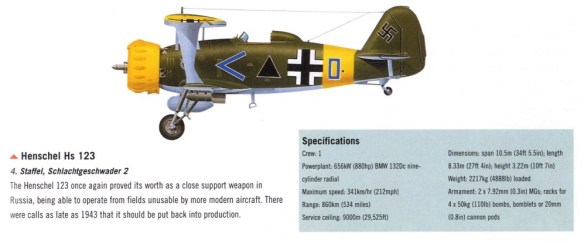
Output of close–support aircraft was in a particularly troublesome situation. The Bf 110, Willy Messerschmitt’s twin–engine design that had been originally intended as a long–range heavy fighter, then reduced to the role of fighter–bomber, suffered a complete production breakdown. The monthly output of Bf 110s fell from 123 in February 1941 to only 1 in December 1941 – and not even 1 in January 1942 – at a time when the Bf 110 units were being rushed back to the Eastern Front to help stem the tide of the Red Army’s Winter counteroffensive! The disaster resulted from Messerschmitt’s miscarriage of producing an aircraft type that was intended to be the successor of the Bf 110, the Me 210. The Me 210 proved to be a construction failure, but it was not withdrawn before serial production had begun. Only slowly was the Bf 110 production crisis resolved, and forty two Bf 110s were delivered in March 1942. The Ju 87 Stuka – the very symbol of the Blitzkrieg – had been obsolete for modem aerial warfare by the outbreak of the war. During the Battle of Britain, increasing losses of Ju 87s to RAF fighters compelled the Luftwaffe commanders to pull back all remaining aircraft of this type from combat service.
Although the Stukageschwader experienced a revival during the first months of Operation Barbarossa, in the summer of 1941, the appearance of new and faster Soviet fighter planes made it obvious that a successor was needed. Production of the Ju 87 also was planned to be phased out. The output of Ju 87s decreased and almost terminated toward the end of 1941. But since no adequate replacement types were available, the needs deriving from the critical situation on the Eastern Front compelled the Germans to reinstate the Ju 87 into production from January 1942. A new version, the Ju 87 D, better armored, better equipped and with stronger defensive armament, entered service in early 1942, replacing the old Ju 87 B. But the dominant weakness of the Ju 87 – its slow speed – was not overcome. Nevertheless, it should be stressed that most airmen of the Stukageschwader, who generally were characterized by their high combat spirit, received the new Ju 87 D with great enthusiasm. Friedrich Lang, who flew as an Oberleutnant with L/St.G. 2 in 1942, said: “This aircraft was easy to handle. Its armament and bomb load was increased within one year from one 500kg bomb and one fixed and one flexible machine gun to one 1,800kg bomb, two fixed 7.92mm machine guns and a fixed twin 7.92mm machine gun.” The output of Ju 87s increased from 476 in 1941 to 960 in 1942.
With the creation of the first Schlachtgeschwader ground-attack wing – in 1942, the Luftwaffe considerably improved the structure of its ground attack force. But the technical equipment did not follow the improvements in organizational structure. At the beginning of 1942, the only operational aircraft type expressly designed as a ground attack plane remained the old Hs 123 biplane. In January 1942, one Staffel – 10.(S)/LG 2 (later to be reformed into 8./SchG 1) – was the only unit operating this aircraft type on the Eastern Front. The bulk of the Luftwaffe in Early 1942 aircraft composition of SchG 1 was Bf 109 Es with liquid., cooled aircraft engines and thus extremely vulnerable to ground fire. A new aircraft type entirely designed for the ground-attack role was being completed in early 1942 – the heavily armored twin-engine Hs 129. But the Hs 129 proved to be a disappointment as it entered service in May 1942. The French-designed Gnome-Rhone 14M engine had a dangerous tendency to seize without warning during operations on the Eastern Front. Two other major deficits of this aircraft type were relatively slow speed and the lack of any rear firing armament, which contributed to making the Hs 129 somewhat vulnerable to enemy fighters. Moreover, these aircraft had rather poor visibility to the sides and rear, which made it difficult to spot attacking enemy fighters in time to evade them.